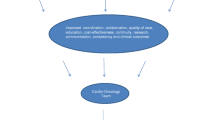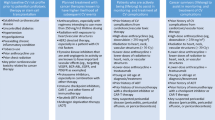Abstract
Purpose of Review
This review aims to outline the general principles of how to build a cardio-onco-hematology clinic, acknowledging that there are diverse practices ranging from private community settings to academic hospitals and each practice environment has to build its own program.
Recent Findings
The refinement of regimens and introduction of molecularly directed therapies have substantially increased survival rates for patients with cancer. In fact, a number of previous imminently fatal malignant disease processes have been turned into chronic diseases, such that patients now live with certain incurable cancers as they do, for instance, with rheumatoid arthritis. Improved cure rates and longer survivals have raised side effects of cancer treatments to a completely new level of significance. Cardiovascular toxicities are of particular concern given their impact on morbidity and mortality. In most extreme cases, patients might be cured from cancer but remain debilitated or die prematurely because of cardiovascular disease. Furthermore, not an insignificant proportion of cancer patients start cancer therapy with cardiovascular risk factors and diseases at baseline. With the aging of the population, this “joint venture” is only expected to increase with important implications for the management of cancer patients.
Summary
Given the need for familiarity with both, cancer and cardiovascular diseases and their ever-evolving start-of-the-art therapy and interaction potential, specialized efforts have been invoked, which may collectively be termed “onco-cardiology,” “cardio-oncology,” or “cardio-onco-hematology.” Herein, we provide recommendations for the creation and optimization of any such programmatic efforts.




Similar content being viewed by others
References
Papers of particular interest, published recently, have been highlighted as: • Of importance •• Of major importance
Albini APG, Donatelli F, Cammarota R, De Flora S, Noonan DM. Cardiotoxicity of anticancer drugs: the need for cardio-oncology and cardio-oncological prevention. J Natl Cancer Inst. 2010;102:14–25.
Yoon GJ, Telli ML, Kao DP, Matsuda KY, Carlson RW, Witteles RM. Left ventricular dysfunction in patients receiving cardiotoxic cancer therapies are clinicians responding optimally? J Am Coll Cardiol. 2010;56(20):1644–50.
LA Herrmann J, Sandhu NP, Villarraga HR, Mulvagh SL, Kohli M. Evaluation and management of patients with heart disease and cancer: cardio-oncology. Mayo Clin Proc. 2014;89:1287–306.
LA Herrmann J. An update on cardio-oncology. Trends Cardiovasc Med. 2014;24:285–95.
Bluethmann SM, Mariotto AB, Rowland JH. Anticipating the “silver tsunami”: prevalence trajectories and comorbidity burden among older cancer survivors in the United States. Cancer Epidemiol Biomark Prev. 2016;25(7):1029–36.
• Parent S, Pituskin E, Paterson DI. The cardio-oncology program: a multidisciplinary approach to the care of cancer patients with cardiovascular disease. Can J Cardiol. 2016;32(7):847–51. A concise review of the multidisciplinary nature and various elements of the cardio-onco-hematology program. Provides unique wait time proposals for wait times for cardio-onco-hematology clinics.
Stairmand J, Signal L, Sarfati D, Jackson C, Batten L, Holdaway M, et al. Consideration of comorbidity in treatment decision making in multidisciplinary cancer team meetings: a systematic review. Ann Oncol. 2015;26(7):1325–32.
Land LH, Dalton SO, Jensen MB, Ewertz M. Impact of comorbidity on mortality: a cohort study of 62,591 Danish women diagnosed with early breast cancer, 1990–2008. Breast Cancer Res Treat. 2012;131(3):1013–20.
Hanrahan EO, Gonzalez-Angulo AM, Giordano SH, Rouzier R, Broglio KR, Hortobagyi GN, et al. Overall survival and cause-specific mortality of patients with stage T1a,bN0M0 breast carcinoma. J Clin Oncol. 2007;25(31):4952–60.
Lee CK, Aeppli D, Nierengarten ME. The need for long-term surveillance for patients treated with curative radiotherapy for Hodgkin’s disease: University of Minnesota experience. Int J Radiat Oncol Biol Phys. 2000;48(1):169–79.
Armenian SH, Xu L, Ky B, Sun C, Farol LT, Pal SK, et al. Cardiovascular disease among survivors of adult-onset cancer: a community-based retrospective cohort study. J Clin Oncol. 2016;34(10):1122–30.
Squires RW, Shultz AM, Herrmann J. Exercise training and cardiovascular health in cancer patients. Curr Oncol Rep. 2018;20(3):27.
Al-Kindi SG, Oliveira GH. Prevalence of preexisting cardiovascular disease in patients with different types of cancer: the unmet need for onco-cardiology. Mayo Clin Proc. 2016;91(1):81–3.
Bhatia N, Lenihan D, Sawyer DB, Lenneman CG. Getting the SCOOP-survey of cardiovascular outcomes from oncology patients during survivorship. Am J Med Sci. 2016;351(6):570–5.
• MG BA, Carver JR, Chen MH, Freeman AM, Herrmann J, Iliescu C, et al. Cardiovascular health of patients with cancer and cancer survivors: a roadmap to the next level. J Am Coll Cardiol. 2015;65:2739–46. Important white paper style document of an cardio-oncololgy expert group comvened by the American College of Cardiology to define the practice landscape. It includes an insightful survey of cardiologists on needs and barriers to cardio-onco-hematology services.
Okwuosa T, Barac A. Burgeoning cardio-oncology programs: challenges and opportunities for early career cardiologists/faculty directors. J Am Coll Cardiol. 2015;66:1193–7.
•• Snipelisky D, Park JY, Lerman A, Mulvagh S, Lin G, Pereira N, et al. How to develop a cardio-oncology clinic. Heart Fail Clin. 2017;13(2):347–59. The first article to speficically outline how to develop a cardio-onco-hematology program. It defined three milestones each with three steps. The current article refines this approach.
• Canale ML, Lestuzzi C, Bisceglia I, Vallerio P, Parrini I, Associazione Nazionale Medici Cardiologi Ospedalieri Cardio-Oncology Task F. Cardio-oncology organization patterns in Italy: one size does not fit all. J Cardiovasc Med (Hagerstown). 2018;19(5):229–233. A unique document on the cardio-onco-hematology practice environment in Italy. It emphasizes the different sizes of practice and their advantages and disadvantages as well as potential symbiosis.
Barros-Gomes S, Herrmann J, Mulvagh SL, Lerman A, Lin G, Villarraga HR. Rationale for setting up a cardio-oncology unit: our experience at Mayo Clinic. Cardio-Oncology. 2016;2:1–9.
Gujral DMMC, Lloyd G, Bhattacharyya S. Organisation & models of cardio-oncology clinics. Int J Cardiol. 2016;214:381–2.
Fleissig AJV, Catt S, Fallowfield L. Multidisciplinary teams in cancer care: are they effective in the UK? Lancet Oncol. 2006;7:935–43.
Author information
Authors and Affiliations
Corresponding author
Ethics declarations
Conflict of Interest
Joerg Herrmann, Charles Loprinzi, and Kathryn Ruddy declare they have no conflict of interest.
Human and Animal Rights and Informed Consent
This article does not contain any studies with human or animal subjects performed by any of the authors.
Additional information
This article is part of the Topical Collection on Cardio-oncology
Rights and permissions
About this article
Cite this article
Herrmann, J., Loprinzi, C. & Ruddy, K. Building a Cardio-Onco-Hematology Program. Curr Oncol Rep 20, 81 (2018). https://doi.org/10.1007/s11912-018-0725-7
Published:
DOI: https://doi.org/10.1007/s11912-018-0725-7




